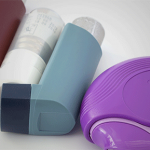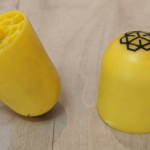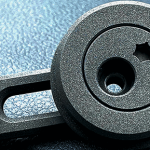- Home
- 3D Printing
- Choosing a 3D printing technology: when is PolyJet best?
Choosing a 3D printing technology: when is PolyJet best?
Every 3D printing technology has its advantages and disadvantages. This is why we have several different technologies here at Prototype Projects – so we can always offer the optimum for making any given part. For some projects, SLA might be ideal; for others, SLS could be better. In this article we are taking a detailed look at PolyJet to see when this might be the best 3D printing technology for your project.
What is PolyJet?
PolyJet, also known as material jetting, is a 3D printing (additive manufacturing) technology that uses liquid photopolymers. The materials are applied with a printing head that has very fine nozzles, rather like an inkjet printing head. As soon as the droplets are applied, they are cured with UV light, which both solidifies the material and fuses it to the layer beneath. The printing head moves in the X and Y axes to print a layer, then the bed moves downwards in the Z axis so the next layer can be printed.
Because the droplets are tiny and the movements in X, Y and Z are very precise, the PolyJet 3D printer builds parts with fine resolution and excellent accuracy.
Furthermore, the print head contains multiple nozzles, so more than one material can be printed concurrently. This enables parts to be built with different material properties in different areas, such as for simulating overmoulded elastomeric grips. Alternatively, droplets of different materials can be printed together, so the resultant composite material (referred to as a digital material) can possess a range of different properties, depending on the base materials used and the way in which they are combined.
The UV light cures the material completely, so there is no need to post-process the finished part in a UV curing oven, unlike other 3D printing technologies utilising photopolymer liquid resins.
PolyJet 3D printing machine capabilities
We have a Stratasys Objet 260 Connex 3 machine with triple-jetting technology. This has a resolution of 600 dpi in the X and Y axes and 1600 dpi in the Z axis. Features smaller than 50 mm have an accuracy of 20-85 microns, while larger parts are accurate to 200 microns. The machine’s build envelope is 255 x 252 x 200 mm (XYZ).
PolyJet 3D printing materials
PolyJet 3D printers can operate with most of the photopolymer liquid resins used in SLA and DLP 3D printers. This gives, potentially, thousands of materials with which to build models. However, in order to build the parts our customers typically want, and to ensure we always have the right materials in stock, we use three base materials. Limiting the range also means we are very familiar with the way in which the materials behave. We can therefore be confident of achieving a fast turnaround, which might not be the case if we were continually learning about the processing nuances of materials we had not used before.
In short, we can use our PolyJet 3D printer to build parts that are rigid and opaque, transparent, similar to polypropylene, or rubber-like with Shore A hardnesses from 30 to 95.
For more information, see our PolyJet Materials Guide.
Pros and cons of PolyJet
PolyJet is a remarkably versatile 3D printing technology. However, as with any other 3D printing technology, it is not perfect for every application. All 3D printing technologies have their advantages and disadvantages but here is a summary for PolyJet:
Advantages of PolyJet are:
- Extremely versatile technology
- Suitable for a wide variety of prototype and end-use parts
- Parts have excellent accuracy and surface finish, even when the geometry is complex
- Suitable for parts with fine detail
- Prints multiple materials simultaneously so different areas of the part can have different material properties
- Base materials can be combined to create digital materials with properties that can be fine-tuned
- Minimal finishing required (typically removal of support structures and witness marks, followed by washing in a cleaning solution)
- Support structures are built with a water-soluble material, so these can be removed easily to leave little or no witness mark
- Hard grades of material can be drilled, tapped, sanded and painted or lacquered
- Internal surfaces can accept a blackout/EMI/RFI coating
- Quicker than SLA
Disadvantages of PolyJet are:
- More expensive than SLA, DLP or SLS
- Parts can be slightly porous but they can be sealed by lacquering
- Parts have anisotropic material properties (weaker in Z axis)
- Long-term exposure to heat, sunlight and humidity can cause warpage and loss of strength
- Parts are not as strong as SLS or FDM parts, depending on the materials used
- Liquid resins require care with storage, handling and disposal
- Our PolyJet machine is not located in our medical cell, so we cannot use it to produce parts for medical device prototyping where patient contact is necessary
Typical applications
Our customers typically request PolyJet parts for the following applications. However, the versatile nature of the technology means it can be suitable for others too. PolyJet is popular among customers in the automotive, aerospace, consumer goods, electronics and medical sectors.
- Concept models
- Visual models
- Functional prototypes
- Prototype parts simulating overmoulded (co-moulded) production parts
- Jigs and fixtures
- Low-volume production parts for end-use applications, depending on environmental conditions
Fixtures are an interesting application for PolyJet parts. For example, parts can be printed with living hinges and snap fits for securing components during processing or assembly. In addition, nests, grippers and other ‘contact’ parts can incorporate soft elastomeric areas so high-quality surfaces or delicate components are not damaged.
When would we not recommend PolyJet?
Because of the few disadvantages and limitations inherent in the PolyJet technology, there are some applications for which we do not recommend its use – though there can be exceptions, of course.
- Parts exposed to elevated temperatures, sunlight or moisture
- End use parts requiring long-term strength and durability
- Large parts
- Parts for which cost is more important than aesthetics, accuracy or function
- Parts for medical devices and drug delivery devices where patient contact is required
Conclusion
Thanks to its multi-material capability and high accuracy, PolyJet is a very versatile technology for 3D printing prototype parts and some end use parts. Customers often find that PolyJet is the only feasible technology for producing prototype parts. If durability of PolyJet parts is an issue, alternative processes such as vacuum casting in polyurethane resin might be better, but this requires more time.
For projects with tight timescales, we offer an Express service for PolyJet 3D printing, with parts shipped the next working day. We never compromise on quality to achieve a fast turnaround, though we do to restrict the choice of finishes for Express parts. When economy is more important than speed, you can choose from our Standard or Economy services. Click here to see our service levels.
Talk to us
If PolyJet is the right technology for producing your prototype or end-use parts, or if you want to discuss our other 3D printing technologies, contact us on 01763 249760.





